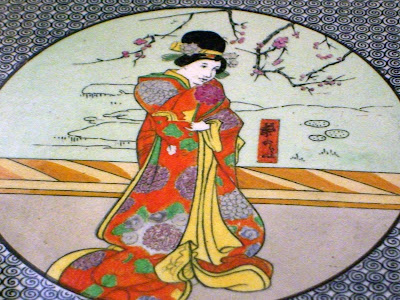Newly invented inlaid tiles of the 1850's were made to simulate mosaics




Tiles with Islamic inspired designs from Alhambra and the Moors in Spain (above)

 Tiles featuring Chinese designs (above) and Japanese threatrical tiles from Wedgewood and Sons, Stratfordshire 1875 (below)
Tiles featuring Chinese designs (above) and Japanese threatrical tiles from Wedgewood and Sons, Stratfordshire 1875 (below)
 There were quite a number of tile displays at the British museum and featured noticeably was Minton and Company. Minton entered into partnership with Michael Hollins in 1845 and formed the tile making firm of Minton Hollins & Co. which was at the forefront of a large newly developing market, supplying tiles and decorative finishes for walls and floors in churches, public buildings, grand palaces and domestic houses. One of my favourite type of tiles developed by the Minton company was the Art Nouveau majolica tiles which were exported world wide from Britain and were a favourite with the Peranakans in Singapore, Malacca and Penang in the late 1800's and early 1900's.
There were quite a number of tile displays at the British museum and featured noticeably was Minton and Company. Minton entered into partnership with Michael Hollins in 1845 and formed the tile making firm of Minton Hollins & Co. which was at the forefront of a large newly developing market, supplying tiles and decorative finishes for walls and floors in churches, public buildings, grand palaces and domestic houses. One of my favourite type of tiles developed by the Minton company was the Art Nouveau majolica tiles which were exported world wide from Britain and were a favourite with the Peranakans in Singapore, Malacca and Penang in the late 1800's and early 1900's.

 Tiles featuring Chinese designs (above) and Japanese threatrical tiles from Wedgewood and Sons, Stratfordshire 1875 (below)
Tiles featuring Chinese designs (above) and Japanese threatrical tiles from Wedgewood and Sons, Stratfordshire 1875 (below) There were quite a number of tile displays at the British museum and featured noticeably was Minton and Company. Minton entered into partnership with Michael Hollins in 1845 and formed the tile making firm of Minton Hollins & Co. which was at the forefront of a large newly developing market, supplying tiles and decorative finishes for walls and floors in churches, public buildings, grand palaces and domestic houses. One of my favourite type of tiles developed by the Minton company was the Art Nouveau majolica tiles which were exported world wide from Britain and were a favourite with the Peranakans in Singapore, Malacca and Penang in the late 1800's and early 1900's.
There were quite a number of tile displays at the British museum and featured noticeably was Minton and Company. Minton entered into partnership with Michael Hollins in 1845 and formed the tile making firm of Minton Hollins & Co. which was at the forefront of a large newly developing market, supplying tiles and decorative finishes for walls and floors in churches, public buildings, grand palaces and domestic houses. One of my favourite type of tiles developed by the Minton company was the Art Nouveau majolica tiles which were exported world wide from Britain and were a favourite with the Peranakans in Singapore, Malacca and Penang in the late 1800's and early 1900's. The exhibits at the British Museum also showed the trends in tile designs and how they were greatly influenced by innovation and culture. This ranges from the invention of inlaid tiles that could similate the Roman mosaics, the Moorish influence of the Alhambra palace in Spain to the Eastern influence of China and Japan.

No comments:
Post a Comment